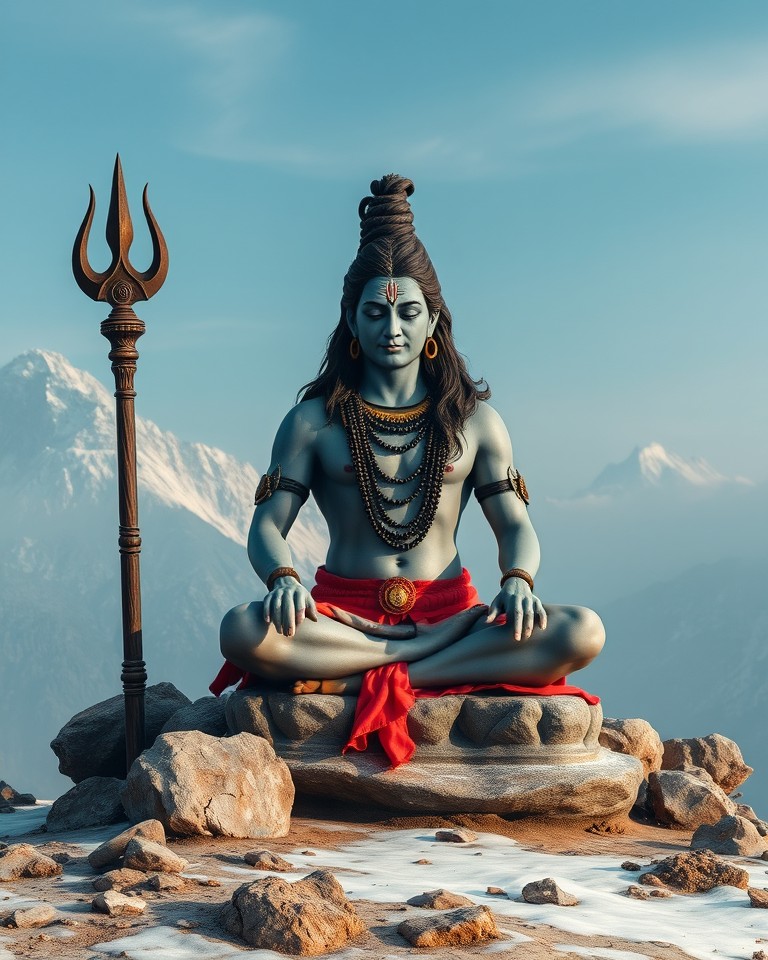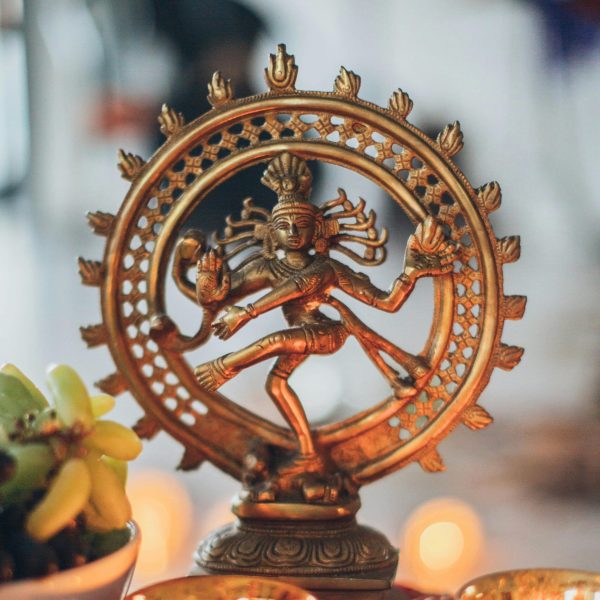Who is Shiva?
‘Shiva’ one of the principal deities in Hinduism, he is often depicted as a yogi that meditates in the mount Kailash. In the holy trinity alongside Brahma and Vishnu his main role is to destroy the universe at the end of each cosmic cycle to pave the way for regeneration and renewal.
Shiva is often depicted with unique symbols:
The third eye on his forehead represents his omniscience and power to destroy evil.
The trident (trishul) signifies his control over the three worlds: physical, mental, and spiritual.
The crescent moon on his head symbolizes the cyclical nature of time.
The snake around his neck (Nagas) represents his control over fear and death.
The ash smeared on his body signifies purity and the essence of all things.
The rudraksha beads he wears are believed to have originated from his tears and are used in meditation practices

Shiva as Nataraja, the cosmic dancer, embodies the universe’s rhythm—where creation and destruction flow in harmony. His dance symbolizes the dynamic balance of life, showing that endings make way for new beginnings. This eternal movement reminds us of life’s impermanence and the seamless cycle of existence. Understanding Shiva’s divine imagery invites individuals to embrace the complexities of life, fostering a deeper connection with the divine and an appreciation for the eternal rhythms that shape our existence. In this light, he emerges not merely as a deity to be worshipped, but as an embodiment of the universal truths that resonate with the human spirit.
Mahashivratri
The Great Night of Shiva:
It is one of the most important Hindu festivals celebrated on the 14th night of the waning moon in the month of Phalguna (February/March). Unlike other festivals Maha-Shivaratri takes place at night. This event stands out for its solemnity and introspective nature, marked by fasting, meditation on Shiva, self-study, social harmony, and an all-night vigil at Shiv temples, rather than the usual cultural revelry.
When is Mahashivratri? Mahashivratri will be celebrated on 26th Feb 2025.
Significance:
- In Shaivism tradition, one legend tells of Shiva performing ‘Shiv Tandav’ his divine dance of creation, preservation, and destruction on this sacred night. Devotees join in this cosmic dance through hymn chanting, scripture reading, and singing, honoring Shiva’s omnipresence.
- Another legend speaks of this night as the divine marriage of Shiva and Parvati. According to different lore, offerings to Shiva icons like the linga are made annually to atone for past sins, embark on a virtuous path, and ultimately attain liberation at Mount Kailasha.
- It is also believed that on this night, Shiva consumed the Halahala poison from the churning of the ocean and held it in his throat, which turned blue, earning him the name Nilakantha.

Cultural Impact and Celebrations
The practices associated with Mahashivratri, such as fasting, meditating, and staying awake through the night, are also seen as beneficial for physical and mental health, aiding in detoxification and the rejuvenation of the body and mind.
On a personal level, Shiva’s teachings of transformation, balance, and inner peace resonate deeply. His dual nature reminds us that destruction and creation are intertwined aspects of life, and embracing change can lead to profound personal growth.
Mahashivratri is celebrated with great fervor across India. Temples are adorned with flowers and lights, and streets come alive with processions, music, and dance.
In cities like Varanasi, Haridwar, and Rishikesh, the festivities are particularly grand, attracting pilgrims from all over the world. Apart from this there are grand celebrations in the 12 Jyotirling’s.
In Mumbai many devotees visit the Babulnath Temple to seek blessings.